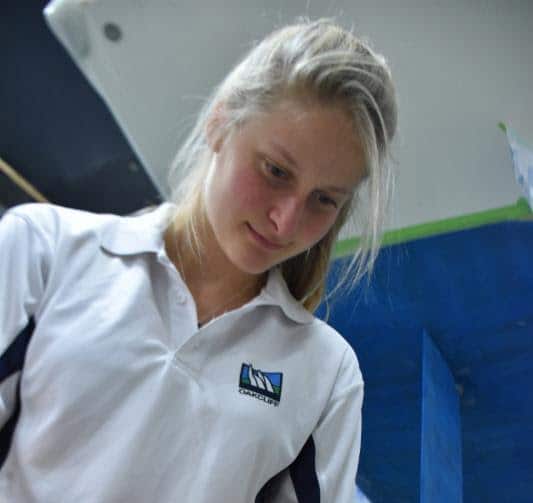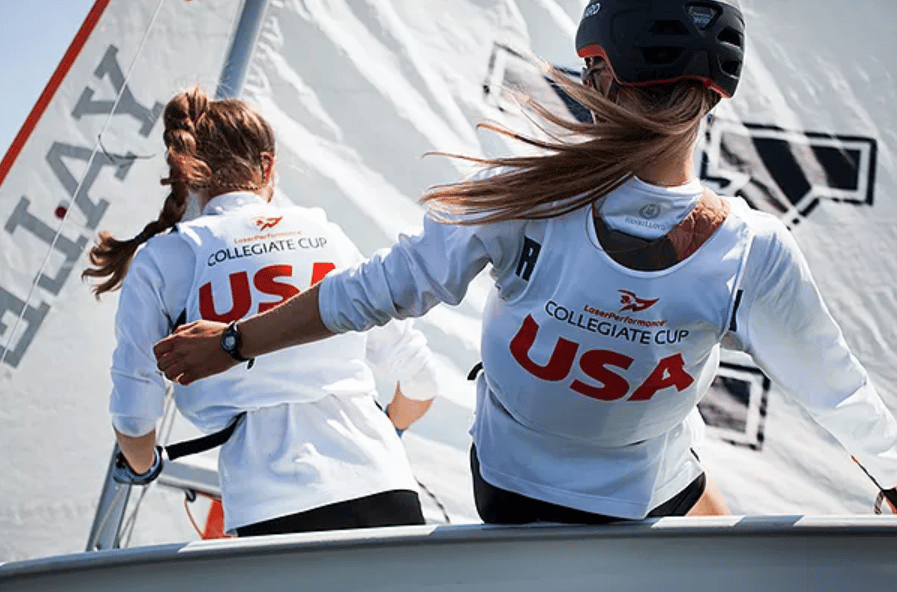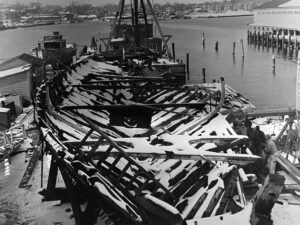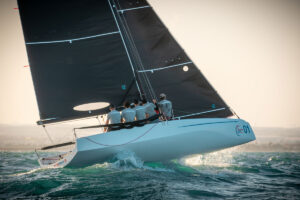Earning a degree in Mechanical and Ocean Engineering from Massachusetts Institute of Technology is no small feat, and it’s an even greater challenge when balanced with the intensive demands of college sailing. For Robyn Lesh, however, the two collegiate challenges led her to a career opportunity of a lifetime.
Lesh, 23, was hired by Bella Mente Quantum Racing, the America’s Cup challenger representing the New York YC, and in her first foray into the Cup, she will have a hand in developing the team’s unconventional 75-foot foiling monohull. While the AC75 design itself is still processing in her mind, she says, her father has already started peppering her with ideas. It was he who introduced Lesh to sailing as an infant, on the family’s cruising sailboat in Everson, Washington. Lesh, however, had never considered a career in the sailing industry until one day at the MIT Sailing Pavilion on the Charles River.
“Toward the end of junior year, my coach pulled me aside to talk about sailing after college, and I was surprised to hear about the opportunities post-grad,” says Lesh.
The conversation gave her a new sense of purpose beyond college sailing. She spent a week at Oakcliff Sailing during the summer before her senior year, enrolled in the high-performance sailing program, and was immediately hooked. She returned to Oakcliff after graduation in 2016 to manage its fleet of high-performance boats, a position that combined Lesh’s passions for engineering and sailing and fed her obsession with foiling and match-racing.

“I didn’t know much about the sailing industry and I didn’t know what I would be most passionate about,” says Lesh. “I knew Oakcliff was the center of the east coast sailing world and I just wanted to come here to learn.”
Lesh is unsure what exactly landed her a spot on Bella Mente’s design team, other than being in the right place at the right time, but she will be the first of others to follow through a recruiting partnership between Bella Mente Quantum Racing and Oakcliff Sailing. BMQR Sailing Team Director, Terry Hutchison, visited the Oyster Bay, New York, sailing facility last year and soon after offered Lesh a coveted spot with the syndicate’s design team.
Lesh is highly motivated in her own right but says her experience at MIT prepared her for what lies ahead in the high-stakes world of the Cup. “At school, it was a constant whirlwind, there were weeks where I would look at my assignments and think, ‘this is not possible, the time does not exist in the days and nights coming up to these deadlines,’” she says. “MIT pushes you past what you think you can do, into what you can actually do. And what I thought I could do versus what I could actually achieve, there was a big gap there, that’s a lesson I’m going to use, because I’m sure it’s going to be intensive.”
In March, Lesh will leave Oakcliff for Santander, Spain, to join the design team under Marcelino Botín. “I will be solely in charge of the weight estimates for our AC75s. This means I will be creating weight accurate 3D models in our initial design process from which we will determine the center of gravity of the boat. From the center of gravity we will determine the center of buoyancy which will determine the shape of the hull but more importantly how the boat will balance while foiling.” After the main design process is completed, Lesh will be confirming the actual weight of components as we build the boats and verifying the accuracy of our estimated weight distributions to guarantee the predicted performance of our boats.

“It’s all new and everyone is on the same page,” says Lesh. “No team has an advantage because we are all starting on a brand-new idea and how to make this boat work. We don’t yet know how to make a foiling monohull without a keel fly stably. It’s going to be an interesting dynamic because new members of the team, like me, are just as valuable and can contribute at a high level because there is no basis to begin with. We are making something that hasn’t ever existed before.”
Making the AC75 fly will be a challenge, but equipped with her experiences, Lesh is up for the task. Already, the physics of making the foils work is on her mind, ”From the initial boat weight and dimension specs, the lifting foil will feel nearly 7 tons of force and the foil will be under substantially more load during maneuvers. To lift the boat, alone, with the lever arm of the length of the foil the joint will need to withstand nearly 100,000N-m of moment with almost no room for an internal lever arm.”
So in layman’s terms, the force is on the end of the foil, where the lift is generated. That force is multiplied by the length of the foil and because the foil is thin and complex, there’s minimal space for internal structure. In addition the foil will need to be fully articulating through a huge range of motion, while experiencing load. Lesh says, “From the prior AC boats the loads on the foils nearly doubled during maneuvers. I don’t expect there is a way to create an articulating joint that can withstand that amount of force without some sort of locking mechanism for when the foils are in lifting mode. A difficult component of a lock is that the boat-lifting foil orientation is in the center of the foils’ range of motion and the foil must articulate in both directions beyond this point. And the whole foil mechanism must be contained in a waterproof compartment!”
In addition to building the most advanced sailboat of our time, Lesh’s personal goal is to help anyone who is passionate about exploring the marine industry, “Being a mentor would be a goal of mine, there was no one I could ask questions to when I was starting, and I want to help people make connections and encourage people to explore,” she says. “I want to help young girls feel that it’s not beyond their reach to achieve on a high level in this field. We can make fuller teams when we jump in.”









